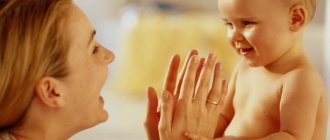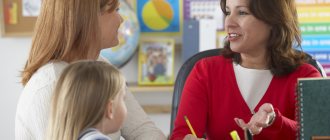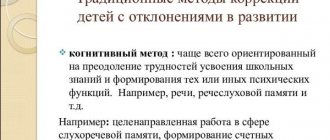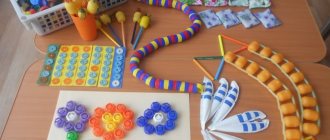Often, parents believe that there is no need to think about the development of the child’s speech if obvious pronunciation defects do not appear (the child has a lisp or does not speak at all). However, many problems in the future can be avoided, and a child’s literate and clear speech can be formed, if you start paying attention to speech development as early as possible throughout the entire period (before one year, and at one year, and at two, and at three...).
Speech development is not at all about working on individual broken sounds or expanding vocabulary, as is commonly thought. The formation of speech depends on the activity of many areas of the brain, so you need to work in all areas: develop fine motor skills, enrich sensory experience, work on articulation, breathing, increase vocabulary, and much more.
I have already written more than once about games that promote speech development in 1-2 years. In this article I would like to put everything together, and also publish many more useful exercises for articulation and breathing exercises and more.
So, games and exercises for speech development:
Finger and gesture games
Scientists have found that in the brain, the nerve centers responsible for the movements of the fingers and hands are in close proximity to the areas of the brain responsible for the development of speech. Therefore, it is simply necessary to promote the active actions of the baby’s fingers and hands. Wonderful helpers in this matter are finger games, I have already written about them more than once; a complete list of interesting finger and gesture games, sorted by age, can be found here:
FROM 1 YEAR
FROM 1 YEAR 3 MONTHS
FROM 1 YEAR 6 MONTHS
FROM 1 YEAR 9 MONTHS
In addition to funny rhymes, it is very useful to learn simple gestures with your baby in the meantime, for example:
- To the question “How old are you?” We show the index finger - “1 year old”;
- We shake our index finger “Ay-ay-ay”;
- We show “yes” and “no” by moving our heads;
- We show “thank you” with a nod of the head;
- To the question “How are you doing?” We show our thumb - “Wow!” ("Great!")
- We depict how the bear walks (feet shoulder-width apart, trampling from foot to foot);
- We depict how a bunny jumps (arms in front of the chest, hands down, jump);
- We depict how a fox walks (wiggle its butt);
- We depict how a wolf clicks its teeth (we open and close our mouth wide, clicking our teeth);
- We depict how a butterfly flies (waving our arms, running around the room);
- We depict how an airplane flies (arms motionless to the sides, we run around the room);
- We depict how a duck walks (we move on our haunches).
- As we approach two years of age, we begin to learn a new answer to the question “How old are you?” and we train to show the index and middle fingers at the same time - “2 years old”. The same finger figure can be called “Bunny”
Recommendations from a psychologist and speech therapist to parents
It is necessary to start learning from an early age; two years is a suitable period for the development of psychological processes and speaking through active joint activities. You can conduct classes with your child several times a day, at home, during a walk. To start the process of speech acquisition, you should follow a number of simple rules:
- Help the baby master the world around him. On the street (especially in the summer), talk more with your child about natural phenomena, what color the surrounding objects are, what are the names of animals running past, visit musical theaters, the circus.
- Develop fine and gross motor skills, engage in modeling. Today you can buy a variety of plasticine in stores: soft, kinetic, plastic, colored dough. Classes contribute to the development of mental processes and perseverance, which is reflected in the speed of speech acquisition.
- Teach your child the names of animals as they speak.
- Kids love to listen to adults read fairy tales and poems. It is a mistaken opinion that a child does not develop when he or she does not read a work independently. When listening, thinking, memory, perception, attention, and comprehension develop. It is important to ask your child questions while reading a fairy tale and discuss the characters. If the baby does not speak, the parents themselves show him an example: “Wow, what a cunning fox, huh?”
Sensory games to develop fine motor skills
A complete list of games for developing fine motor skills can be found here:
FROM 1 YEAR - PART 1, PART 2, PART 3, PART 4
FROM 1 YEAR 3 MONTHS
FROM 1 YEAR 6 MONTHS
FROM 1 YEAR 9 MONTHS
Passive speech stimulation
I’ll start, perhaps, with passive speech development. I decided to include all kinds of massages here.
For example, a rubber massage ball or a spiky plastic ball - su-jok - is perfect. Such classes are necessarily carried out as part of a set of exercises to initiate speech in non-speaking children.
Massage with a ball
Many people underestimate the benefits of a massage with a ball, and in vain. I provided daily activities with my children in the form of games and pampering every evening.
Not only did they like it, but it also has a positive effect on the entire body: blood circulation improves, tactile sensitivity develops, the so-called “speech zones” are stimulated, coordination and fine motor skills are developed.
In general, this is a rather extensive topic, and therefore I have included it in a separate article . There you will find a complete guide on how to exercise profitably and so that your child enjoys it - little personal secrets









